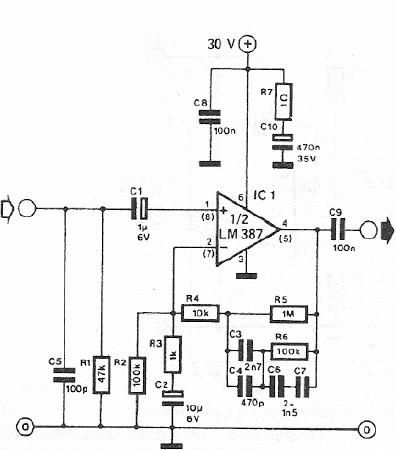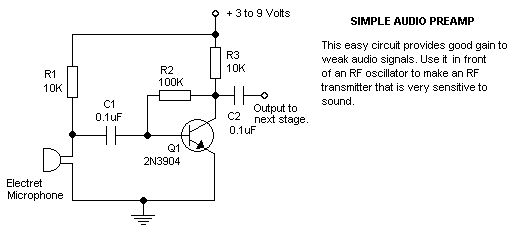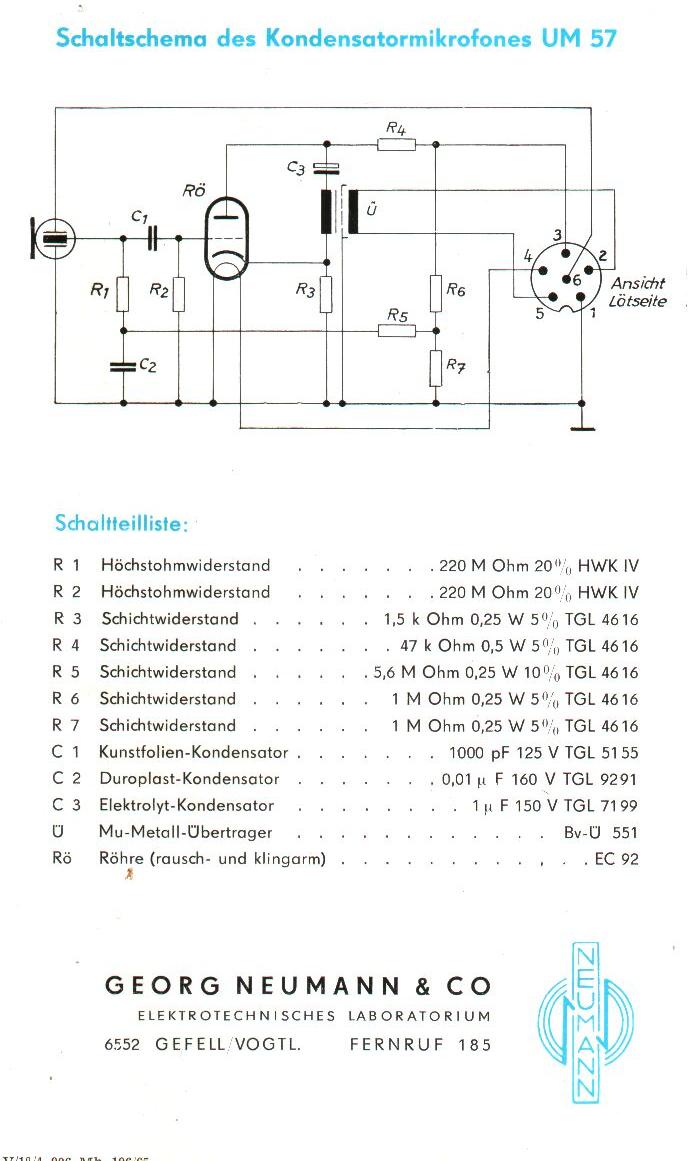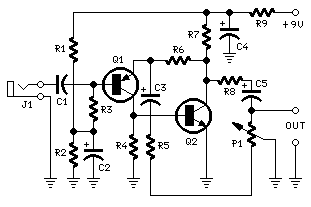
microphone beyerdynamic TG X 50 Mk II
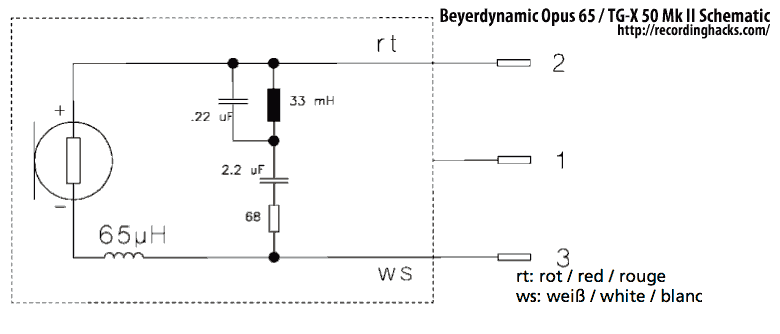
The Mk II was a second-generation version of the TG X 50. Both were dynamic microphones intended for bass instruments and kick drums. The primary difference between the two versions was the introduction of a passive EQ filter in the Mk II. Note that the circuit schematic in the cutsheet linked from the right sidebar is incorrect; it does not show the filter. The simpler schematic in this cutsheet is actually for the original TG-X 50, not the Mk II. The passive EQ filter circuit in the Mk II is pictured here (as diagrammed in the Opus 65 cutsheet). The Mk II's EQ filter is an LCR circuit. As a passive circuit, it can only cut, rather than boost frequencies. Comparing frequency-response measurements of the TG X 50 and TG X 50 Mk II shows the effect of the resulting equalization: a broad mid-frequency scoop of up to 7 dB, from 100 Hz to 1 kHz, and a 3-5 dB cut above 4 kHz. The Mk II literature describes this change: "Durch ein spezielles Filter wird der Frequenzgang entzerrt, wodurch das Mikrofon mehr Tiefbass und Kick bekommt." Roughly translated: "Through a special equalization filter, the microphone produces more bass and kick."
The TG X 50 Mk II microphone features a dynamic design optimized for capturing low-frequency sounds, making it particularly suitable for bass instruments and kick drums. The introduction of a passive equalization (EQ) filter in the Mk II model is a significant enhancement over its predecessor. This filter employs an LCR (inductor-capacitor-resistor) configuration, which is designed to attenuate specific frequency ranges rather than amplify them.
The passive EQ filter's design allows for a tailored frequency response, resulting in a pronounced mid-frequency scoop, effectively reducing levels by up to 7 dB between 100 Hz and 1 kHz. This scooping effect is beneficial for applications where clarity and punch are desired, such as in live sound environments or studio recordings. Additionally, the filter provides a 3-5 dB cut in frequencies above 4 kHz, which can help to minimize unwanted high-frequency noise and enhance the overall warmth of the sound.
The incorrect circuit schematic previously associated with the Mk II model did not accurately depict the presence of the passive EQ filter, leading to potential misunderstandings regarding its operational characteristics. The correct representation of the Mk II's circuit, as shown in the Opus 65 cutsheet, illustrates the integration of the LCR filter into the microphone's design, ensuring that users can fully leverage its capabilities. The literature emphasizes the importance of this filter in enhancing the microphone's performance, particularly in delivering deep bass and impactful kick drum sounds.
In summary, the TG X 50 Mk II's passive EQ filter is a critical feature that distinguishes it from the original TG X 50, providing a specialized frequency response that caters specifically to low-frequency applications.The Mk II was a second-generation version of the TG X 50. Both were dynamic microphones intended for bass instruments and kick drums. The primary difference between the two versions was the introduction of a passive EQ filter in the Mk II. Note that the circuit schematic (Schaltbild ) in the cutsheet linked from the right sidebar is incorrect
” it does not show the filter. The simpler schematic is this cutsheet is actually for the original TG-X 50, not the Mk II. The passive EQ filter circuit in the Mk II is pictured here (as diagrammed in the Opus 65 cutsheet). The Mk II`s EQ filter is an LCR circuit. As a passive circuit, it can only cut, rather than boost frequencies. Comparing frequency-response measurements of the TG X 50 and TG X 50 Mk II shows the effect of the resulting equalization: a broad mid-frequency scoop of up to 7dB, from 100Hz to 1kHz, and a 3 5dB cut above 4kHz. The Mk II literature describes this change: Durch ein spezielles Filter wird der Frequenzgang entzerrt, wodurch das Mikrofon mehr Tiefbass und Kick bekommt.
Roughly translated: Through a special equalization filter, the microphone produces more bass and kick. 🔗 External reference
The TG X 50 Mk II microphone features a dynamic design optimized for capturing low-frequency sounds, making it particularly suitable for bass instruments and kick drums. The introduction of a passive equalization (EQ) filter in the Mk II model is a significant enhancement over its predecessor. This filter employs an LCR (inductor-capacitor-resistor) configuration, which is designed to attenuate specific frequency ranges rather than amplify them.
The passive EQ filter's design allows for a tailored frequency response, resulting in a pronounced mid-frequency scoop, effectively reducing levels by up to 7 dB between 100 Hz and 1 kHz. This scooping effect is beneficial for applications where clarity and punch are desired, such as in live sound environments or studio recordings. Additionally, the filter provides a 3-5 dB cut in frequencies above 4 kHz, which can help to minimize unwanted high-frequency noise and enhance the overall warmth of the sound.
The incorrect circuit schematic previously associated with the Mk II model did not accurately depict the presence of the passive EQ filter, leading to potential misunderstandings regarding its operational characteristics. The correct representation of the Mk II's circuit, as shown in the Opus 65 cutsheet, illustrates the integration of the LCR filter into the microphone's design, ensuring that users can fully leverage its capabilities. The literature emphasizes the importance of this filter in enhancing the microphone's performance, particularly in delivering deep bass and impactful kick drum sounds.
In summary, the TG X 50 Mk II's passive EQ filter is a critical feature that distinguishes it from the original TG X 50, providing a specialized frequency response that caters specifically to low-frequency applications.The Mk II was a second-generation version of the TG X 50. Both were dynamic microphones intended for bass instruments and kick drums. The primary difference between the two versions was the introduction of a passive EQ filter in the Mk II. Note that the circuit schematic (Schaltbild ) in the cutsheet linked from the right sidebar is incorrect
” it does not show the filter. The simpler schematic is this cutsheet is actually for the original TG-X 50, not the Mk II. The passive EQ filter circuit in the Mk II is pictured here (as diagrammed in the Opus 65 cutsheet). The Mk II`s EQ filter is an LCR circuit. As a passive circuit, it can only cut, rather than boost frequencies. Comparing frequency-response measurements of the TG X 50 and TG X 50 Mk II shows the effect of the resulting equalization: a broad mid-frequency scoop of up to 7dB, from 100Hz to 1kHz, and a 3 5dB cut above 4kHz. The Mk II literature describes this change: Durch ein spezielles Filter wird der Frequenzgang entzerrt, wodurch das Mikrofon mehr Tiefbass und Kick bekommt.
Roughly translated: Through a special equalization filter, the microphone produces more bass and kick. 🔗 External reference
